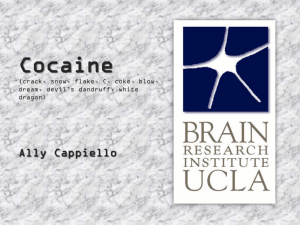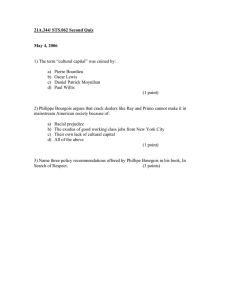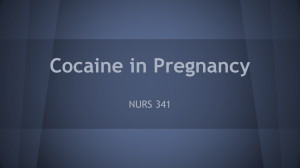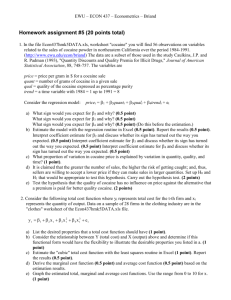Drugs and Our Society Stimulants Cocaine / Amphetamines / Caffeine / Nicotine
advertisement
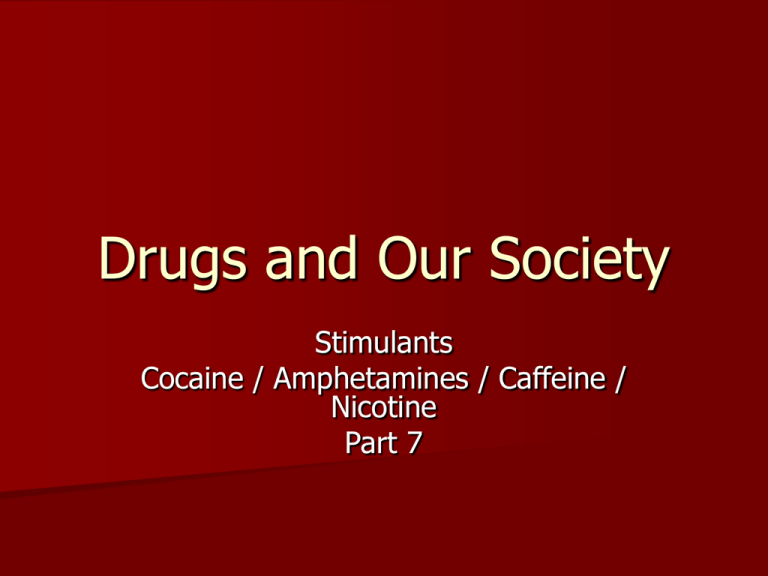
Drugs and Our Society Stimulants Cocaine / Amphetamines / Caffeine / Nicotine Part 7 Stimulants 1. 2. During times of fatigue and lethargy - people at times look for substances to elevate their mood - to make them energetic - and stimulates provide these effects They modify a person’s activity level / mood / and central nervous system - cocaine and methamphetamine are illegal - other amphetamines require a prescription - still others, caffeine and nicotine, are the most widely used drugs in the world Stimulants, cont 3. 4. They impact the CNS - speeding up mental and physical processes in the body - this is why they are called “uppers” Cocaine in 2006 - there are over 3 million occasional users in the United States - occasional users are no more than 12 times in a year - 4 million hardcore use at least once a week Cocaine, cont 5. 6. Cocaine comes from the leaves of the coca plant - specifically, the erythroxylon coca - cocaine is one of 18 alkaloids coming from the plant Natives of the Andes mountains chewed coca leaves to relieve fatigue - it was also used for spiritual reasons and for well-being - many plantation owners paid their workers with coca leaves Cocaine, cont 7. 8. Chewing coca leaves does not seem to cause independence - leaves contain less than 2% cocaine - chewed or brewed in tea does not cause biological harm or social dysfunction There are over 200 types of coca plants, but only 3 types of coca leaves are used in the production of cocaine - Huanuco coca: Bolivia and Peru - Amazonian coca: Amazon River region - Colombian coca: Columbia Cocaine, cont 9. 10. According to the US Department of State, the production levels of cocaine are: - Columbia: 521,400 metric tons (1,042,800,000 lbs) - Peru: 69,200 metric tons (138,400,000 lbs.) - Bolivia: 22,800 metric tons (45,600,000 lbs.) The cocaine trade is run by drug cartels - they maintain their own small armies - using force and fear to protect their empires Properties of cocaine 1. 2. 3. It is an odorless, crystalline, white powder - producing intense euphoria / alertness / and energy - it also inhibits appetite and sleep It works on that portion of the brain that controls pleasure and reinforcement - it is directly related to the effect of dopamine Methods of intake: snorted / smoked / and injected Cocaine, cont 4. 5. Snorted cocaine - effects in about 3 minutes - peaks after 15 to 20 minutes - wears off in 60 to 90 minutes Injected cocaine - effects within seconds (8 to 10) - almost instantaneous - peaking in 3 to 5 minutes - wears off in 30 to 40 minutes Crack cocaine 1. 2. Crack emerged in the 1980s, but was first reported in the late 1970s - it is a product of mixing cocaine with baking powder and water - it is then heated - this is referred to as freebase (2 methods) This process produces small chunks or rocks - these can be smoked - which is the usual method - but it can also be injected Crack cocaine, cont 3. 4. The euphoria from crack is brief - it lasts about 10 to 20 minutes - the desire to repeat usage is high - but most people who have used crack do not continue to use it Crack has been related to violence - but that is primarily due to the drug trade - 300 gang members in San Francisco who do not use the drug, but use violence to control the selling of crack Cocaine Paraphernalia 1. 2. What police officers look for - dealers: mirrors / razor blades / scales used to weigh drug / pagers / cell phones - users: mirror / coke spoon / fancy straws / odd assortment of containers / white powder on the nose / crack pipe Thinking Critically “Cocaine use can be reduced by reducing the amount of cocaine entering the country or by reducing the demand for the drug. Do you favor more enforcement or persuading people not to take drugs?” Popularity of cocaine 1. 2. Entertainment and the media - glorifies drug use - people who deal have the money and power - news stories talk of the failure of the police Music - 1930’s/1940’s: Cole Porter’s “I Get a Kick Out of you” - “I get no kick from cocaine, I’m sure that if I took even one sniff, it would bore me terrifically too, but I still get a kick out of you” Popularity, cont 3. 4. 1960’s the reference to drugs in music were increasing - Grateful Dead: “Casey Jones”/“Let It Bleed” - Rolling Stones: “Sister Morphine” - Eric Clapton: “Cocaine” Literature - references to cocaine are found in fiction and non-fiction novels - “Snowblind”: John Belushi’s life story - even found in comic books read by children Physical and psychological effects of cocaine 1. Research to date has not found a “cocaine personality” - not all cocaine users experience dependence and/or withdrawal - but they do build up a tolerance to effects of the drug - withdrawal symptoms are not like narcotic withdrawal - it does include depression / lack of energy / poor appetite / less pleasure from activities / restlessness / agitation Physical / psychological effects, cont 2. 3 phases follow abstinence of chronic users - intense craving: agitation / anorexia / deep depression (this “crash” can last from 9 hours up to 4 days) - withdrawal: incapable of feeling normal pleasure /moderate depression / sleeplessness can last up to 10 weeks (usually stabilizes after 7 to 10 days) - Extinction: improvement is considerable / periods of depression (occasional cravings can last for months or even years) Death from cocaine 1. 2. 3. 4. 5. Can cause irregular heartbeat / high blood pressure / chest pains / and can trigger heart attacks It is capable of destroying the heart muscle - by disrupting the blood supply Coronary artery disease is relatively common in cocaine users Uncontrolled seizures / strokes / paralysis of the breathing muscles can also occur Lethal doses of cocaine have not yet been determined Death, cont 6. - some people die from relatively low levels - or by mixing their drugs (polydrug) Dawn (Drug Abuse Warning Network) - almost 5000 people die yearly from cocaine use - mostly males over the age of 35

